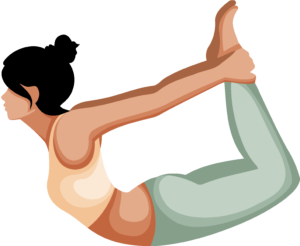Standing Backbend/Upward Bow/Upward Wheel (Urdhva Dhanurasana)
Pose Overview
| Common Name | Standing Backbend, Upward Bow, Upward Wheel |
| Traditional Sanskrit Name | Urdhva Dhanurasana |
| Sanskrit Name Pronunciation | oord-vah dahn-yoor-AH-sah-na |
| Pose Difficulty | Advanced |
| Drishti
Drishti is the gaze or visual focus point during yoga poses.
Learn more about Drishti |
Upward, towards the sky |
Upward Wheel Pose, or Urdhva Dhanurasana in Sanskrit, is a yoga pose that is said to be beneficial for strengthening the back, glutes, and thighs, as well as for promoting a sense of balance and focus. The name of the pose comes from the fact that it resembles an upward facing bow or wheel, with the body in an arched position with the legs and arms on the floor and the chest lifted up. The pose is said to be helpful for increasing flexibility and strength in the muscles of the back, glutes, and thighs, and for promoting a sense of balance and focus. It is also said to be beneficial for relieving stress and anxiety, and for promoting a sense of inner peace. This pose is also said to help to tone the back, glutes, and thighs, and to help to improve balance and stability.
Benefits of Standing Backbend, Upward Bow, Upward Wheel
Upward Wheel is a great pose for building core strength, as well as increasing flexibility in the spine and shoulders. It can also help to improve posture, stimulate the thyroid and pituitary glands, and energize the body.
How to Enter Standing Backbend, Upward Bow, Upward Wheel
Begin on your back with your knees bent and feet flat on the floor, hip-width apart. Place your hands on the floor beside your head, fingers pointing towards your shoulders. Press into your hands and feet to lift your hips off the floor. Keep your elbows close to your ribcage as you straighten your arms and lift your head and shoulders off the floor. Engage your core and lift your hips higher, pressing your feet and hands into the ground. Keep your gaze forward and hold the pose for a few breaths before releasing.
How to Exit Standing Backbend, Upward Bow, Upward Wheel
Lower your hips to the floor, keeping your gaze forward and your core engaged. Release your hands and rest your head and shoulders on the ground.
Common Standing Backbend, Upward Bow, Upward Wheel Modifications & Variations
Place a block under your lower back for support if you are unable to lift your hips fully off the ground. Beginners can practice the pose with bent elbows and hands on the lower back for support.
Common Mistakes with Standing Backbend, Upward Bow, Upward Wheel
Arching the lower back instead of lifting the hips. Locking the elbows and straining the shoulders.
Safety Guidance
People with high blood pressure, neck or back injuries should avoid this pose. Those with wrist injuries should be careful with the weight put on the wrists.

